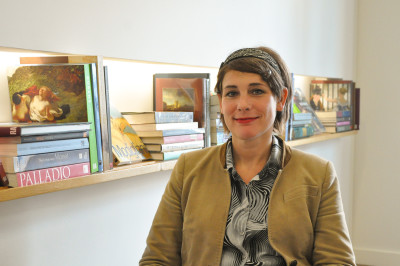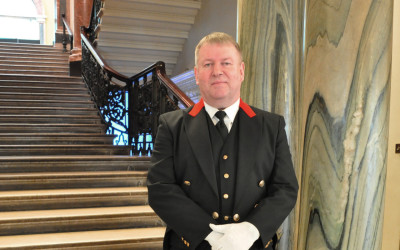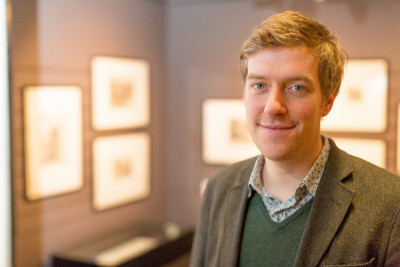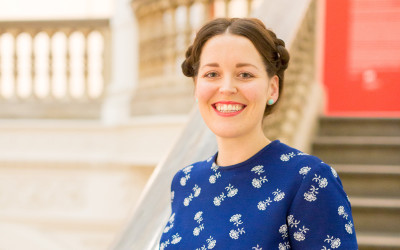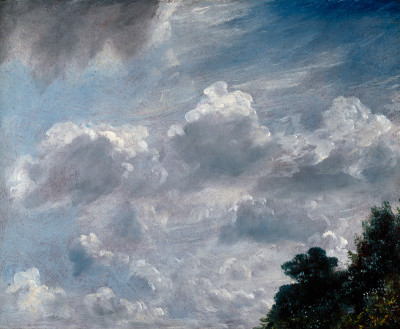A day in the life: Morgan Feely, Collections Manager for Works on Paper
A day in the life: Morgan Feely, Collections Manager for Works on Paper
Ten questions about working at the RA
By Harriet Baker
Published 18 May 2015
As he prepares to open a new retrospective of the work of Eileen Cooper RA, we chat to Morgan Feely about his daily life at the RA.
-
The Tennant Gallery occupies a modest space next to the first floor galleries of the Royal Academy, though the breadth and scope of its exhibitions are anything but. In the past year, the space has housed the work of Gothic book illustrator Charles Stewart, the engraver Stanley Anderson and has hosted exhibitions of work by Academician’s including Norman Shaw and Sir Hugh Casson. Soon, drawings by Eileen Cooper will occupy the space.
As well as organising these exhibitions focusing on Academicians past and present, Morgan, who has worked at the RA since 2002, is responsible for the care of the Academy’s collection of prints and drawings.
How did you come to work at the RA?
I started working here part-time on a six-month contract… twelve years ago! My role just kept growing from there. Before that I had volunteered at the excellent Dulwich Picture Gallery while studying for an MA at the Courtauld Institute of Art. Before that again, while an undergraduate at Trinity College, Dublin, I worked at the Douglas Hyde Gallery, a venue for contemporary art with an ambitious programme that belies its modest resources. That made a big impression on me.
How do you start your working day?
Walking from Piccadilly into the courtyard of Burlington House is not a bad way to arrive at work. It is a wonderful building, with a rich history that has seen it transformed from private house to the home of the RA. My office, which also houses part of the prints and drawings collection and a workspace for conservators, is up a couple of flights of the former butler’s staircase, in an area that was once the bedrooms and attics of Burlington House. When I get there, it takes at least one cup of strong coffee to get me functioning properly.
-

Morgan Feely with conservators working on the Maclise cartoon, which will go on show at the RA from 2 September
Photo: Benedict Johnson © Royal Academy of Arts
-
What does a typical day at the RA look like?
My role involves managing the RA’s collection of prints and drawings and organising the Tennant Gallery programme of exhibitions, so my days are quite varied. Because my shows are small, I am a bit of a Jack-of-all-trades, and enjoy working directly with colleagues across the whole organisation and beyond.
A typical day might involve talking to an external curator, RA colleague, or artist to plan the content of an exhibition; seeing conservators and framers to prepare artworks for display; organising an installation with our Art Handling team; or liaising with our Registrars on loans to other museums. Sometimes I travel as a courier when we lend works of art. I’ve recently had an all-too-short visit to Tokyo for the return leg of an exhibition we’ve had touring in Australia and Japan for more than a year, but it’s more likely to be a trip down the road for a loan to Tate Britain, say. The building is always busy. When we’re installing exhibitions, we start early, before the public come in, and when I leave in the evening, there are often events starting up. But it can’t all be excitement and fun. I spend my fair share of time staring at spreadsheets and swearing at the printer.
What projects have you enjoyed working on?
There have been too many to mention, but some of my favourites have been working directly with artists on Tennant Gallery exhibitions. I loved Mark Hampson’s satire on RA history, Almost Real Art, in 2012. It was cheeky but affectionate, clever and clownish all at the same, and it looked just great. More recently, finding an engaging way to display tiny illustrations by Charles Stewart for Victorian gothic novel Uncle Silas was a challenge at the end of last year. Freelance curator Amanda-Jane Doran and I had fun creating a suitably spooky drawing room setting, with a sofa and chairs (black, naturally) so visitors could dip into a copy of the book.
Also last year we ran a project of conservation treatment and photography on a vast and astonishing drawing by Daniel Maclise of the battle of Waterloo, which will go on show at the Royal Armouries and the RA later this year. This extraordinary drawing had not been seen by anyone at all since 1972. Spending time up close with it was a real treat.
-

'Almost Real Art'

'Charles Stewart: Black and White Gothic'
-
What’s your favourite place to go for lunch nearby?
On a sunny day, it’s good to get out of the Print Room darkness and eat in St. James’s Square, the churchyard of St. James’s, Piccadilly, or Green Park.
What exhibition have you most enjoyed?
I’ve enjoyed far too many to choose just one… Bronze (2012) was beautiful and fascinating. I loved Anish Kapoor (2009) but am really glad not to have been involved in either planning it or cleaning up afterwards. I really like the scale of exhibitions in the Sackler Galleries, and the chance they offer to see less familiar artists, like Vilhelm Hammershøi (2008), or the current show of the work of Richard Diebenkorn. And RA architecture exhibitions can be wonderful; I loved Sensing Spaces last year and Richard Rogers RA in 2013.
Tell us something that most people don’t know about your job role.
We have about 30,000 prints and drawings in our collection, and although they spend most of their time stored in archival boxes, they are seen more than you might imagine. Visitors get excited when the white gloves come out and they hear the rustle of acid-free tissue paper.
What’s different about the RA compared with other places where you’ve worked?
It’s ultimately run by artists, the Royal Academicians. As you might imagine, that keeps things interesting. And it (literally) has a cupboard full of skeletons, once used to teach anatomy to students in the RA Schools.
What advice would you give to someone wanting to go into a career in the arts?
It can be very rewarding but is unlikely to make you rich.
What are your future ambitions?
Although much of my job relates to the art of the past, I really enjoy working with living artists, so I’d like to continue doing this. Fortunately, I’m currently working on an exhibition of drawings by Eileen Cooper RA, and we’re planning more exhibitions with current Academicians after that. Keep an eye on the Tennant Gallery programme to find out more!
Hide and Seek: Drawing By Eileen Cooper RA will be in the Tennant Gallery from 28 May – 23 August 2015.



